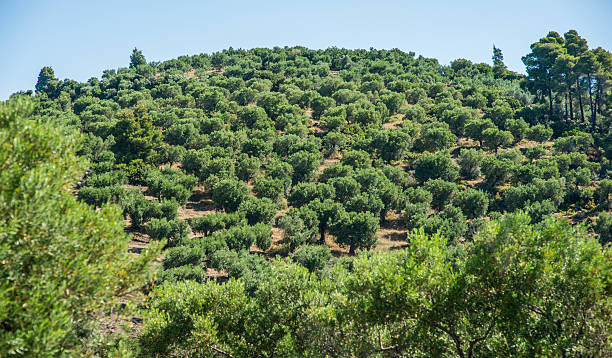3 - Pant Physiology and Growth
Figure I: Chemical process of photosynhesis (The
University of Arizona, 2001)
A plant is a magical creatures that is able to adapt itself
to the environment that it lives in. Besides, crops are the only one that are
able to carry out the Photosynthesis process. These marvelous way of converting
sunlight energy into chemical energy, is apart from amazing also quiet
difficult since it can be done in two different manner (The University of
Arizona, 2001) .
This week’s blog covers the photosynthetic way in which olive tree carry out
photosynthesis and explains the perennial characteristics of the crop.
A C3 or a C4 plant?
The differences between C3 and C4 plant are said to be
important to the crop’s optimal growing conditions, nitrogen and water usage
efficiency (Betts, N.D.) . Since the manner in
which photosyntheisis is carried out in the plant variates, so do plants also
differ in the leaf anatomy and enzymes that is used to perform the
photosynthesic process. So, is the biggest difference between C3 and C4 plant
is the fact that C4 plants have got an extra step wherein it stores CO2 in an
acid form, which is needed in order to prevent water loss in dry climate (Watts,
2017) .
However, dispite this difference, the main principle remains the same: “to
convert light to energy and atmospheric CO2 into plant food energy
(carbohydrates)”.
C3 Plants: cool season plants
Plants that carry out C3 photosynthestic pattern reduce
CO2 (carbon fixaction) directly by
the enzyme ribulose biosphosphate carboxylase (rubisco) in the chloroplast. A 3-phosphoglyceric (three-carbon acid) is formed between
the reaction of CO2 and the enzyme (Khan Academy, N.D.) (Betts, N.D.) .
C4 Plants: warm season plants – tropical plants, the
light-dependent reaction
During photosynthesis these plants reduces CO2 (carbon fixation) in the mesophyll
cells, by first converting CO2 to oxaloatcetate (4-carbon acid), and is carried
out by a non-rubisco enzyme (which is
said to have no tendency to bind O2) (Khan Academy, N.D.) .
that photosynthesis is continue as in C3 plants. However,
C4 type of photosynthesis is said to be hightly efficient since little CO2 is
lost through photo-respiration (Betts, N.D.) . C4 plants are more
efficient in gathering CO2 and is able to use nitrogen from the atmosphere and
in the soil.
I though that my chosen crops was a C4 plant, since
olives trees in Spain grow under high temperature. Therefore, because of this
warm tropical climate, the tree needed to carry out photosynthesis like a C4
plant, little did I know that I was wrong. Hence the olive tree is a C3 plant (Bareja,
2013) ,
despite of growing in warm weather conditions. The olive tree is said to have a
high degree of drought tolerance, due to a very developed osmotic adjustment
and its appearance of leaf anatomical modifications (A. SOFO, 2009) .
Annual, biennial or
a perennial?
Annuals are said to perform their entire life cycle from
seed to flower back to seed in a single growing season. While biennials require
two years to complete their life cycle, whereby in the first growing season
they produce small rosette of leaves near the soil surface. In their second growing
season their stem become longer, the plant start flowering and seed formation
occur, and then the plant die. Lastly, perennials are plants that continue growing
for many seasons, whereby the top part of the crop dies back each winter but
regrows the following spring from the same root system (Wildflowers in Bloom,
N.D.) .
As the olive tree is a long-lived crop and is able to
live from many years to many centuries, it is therefore a perennial plant.
Besides, since they live for many years, they grow slowly and take their time
to expend their root systems very deep into the soil. Because of this they
create a permanent network of roots which will helps them stabilize the soil
and prevent erosion (Permaculture Research
Institute, 2012) .
Moreover, perennials are also said to increase nutrient retention in ecosystem,
improve water infiltration and contribute to climate change adaptation (The Land
Institute, N.D.) .
Additionally, since a perennial continue growing for many seasons, one does
not have to replant the plant every year (The Land Institute,
N.D.) .
References
A. SOFO, B. D. (2009). Photosynthetic
performance and light response of two olive cultivars under different water
and light regimes. Retrieved September 23, 2017, from
file:///C:/Users/Vincit%20Nkouka/AppData/Local/Microsoft/Windows/INetCache/Content.Outlook/TQ4ZWFLL/Drought%20stress%20in%20olive%20trees.pdf
Bareja, B. G. (2013, August). Plant
Types: I. C3 Plants, Comparison. Retrieved September 23, 2017, from
Cropreview: http://www.cropsreview.com/c3-plants.html
Betts, D. L. (N.D.). “What is the difference between C3
plants and C4 plants?”. Retrieved September 18, 2017,
from K-STATE Research and Extension: http://www.midway.k-state.edu/livestock/docs/What%20is%20the%20difference%20between%20C3%20plants%20and%20C4%20plants.pdf
Khan Academy. (N.D.). C3, C4,
and CAM plants. Retrieved September 18, 2017, from Khan Academy:
https://www.khanacademy.org/science/biology/photosynthesis-in-plants/photorespiration--c3-c4-cam-plants/a/c3-c4-and-cam-plants-agriculture
Permaculture Researche Institute.
(2012, June 6). PERENNIAL PLANTS AND PERMACULTURE. Retrieved September
19, 2017, from Permaculture Researche Institute:
https://permaculturenews.org/2012/06/06/perennial-plants-and-permaculture/
The Land Institute. (N.D.). Perennial
Crops: New Hardware for Agriculture. Retrieved September 19, 2017, from
The Land Institute: https://landinstitute.org/our-work/perennial-crops/
The University of Arizona. (2001,
November 27). Photosynthesis. Retrieved September 21, 2017, from the
Biology project of The Universiy of Arizona:
http://www.biology.arizona.edu/biochemistry/problem_sets/intro_photosynthesis/intro.html
Watts, R. (2017, September 18).
Plant Physiology and Growth. (IF2.A, Interviewer) Den Bosch, The Hetherlands.
Retrieved September 18, 2017
Wildflowers in Bloom. (N.D.). Annual,
Perennial, Biennial? Retrieved September 18, 2017, from Wildflowers in
Bloom: http://aggie-horticulture.tamu.edu/wildseed/growing/annual.html



Reacties
Een reactie posten